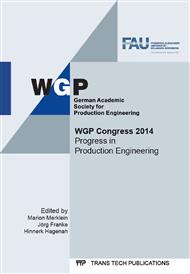p.451
p.461
p.469
p.477
p.485
p.493
p.501
p.509
p.517
Identification and Improvement of Communication in Factories
Abstract:
In this article you find the results of the research project "Modelling and design of dynamic business and communication processes in the factory” which is funded by the German Research Foundation (DFG). The main result is a methodology for the identification and improvement of communication in factories, which consists of the three models: descriptive model, evaluation model, procedure model. The descriptive model is based on the method of matrix modelling and enables the depiction of communication structures. The evaluation model is conductive to the assessment of communication circumstances in the factory and the procedure model explains the course of action necessary for the practical use of the descriptive and evaluation model. According to the developed methodology the three models were implemented in an EXCEL-based software-tool which enables the practical use of the methodology. The software-tool provides a possibility to not only describe the communication structure of factories, but also to identify communication processes necessary to run the factory. Moreover it is possible to detect inadequacies of communication circumstances and derive measures to adjust them appropriately. In the following article the methodology and the software-tool are described in detail. For an optimal comprehension of the methodology each of the three models is detailed. In order to obtain an idea of how the software-tool works and how it looks like, its three components are explained.
Info:
Periodical:
Pages:
485-492
Citation:
Online since:
September 2014
Authors:
Keywords:
Price:
Сopyright:
© 2014 Trans Tech Publications Ltd. All Rights Reserved
Share:
Citation:


